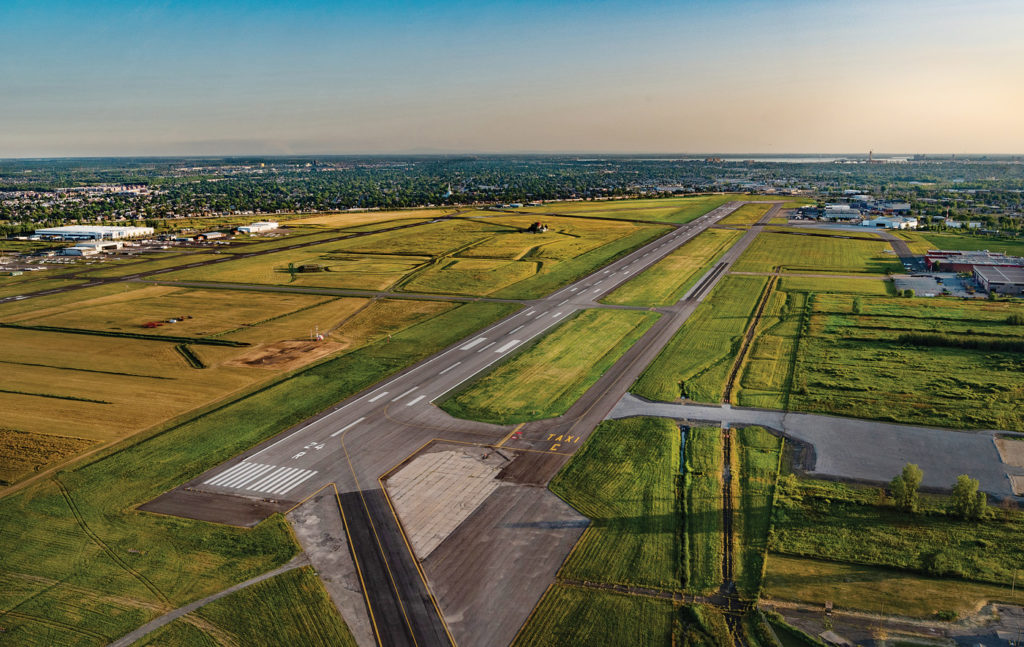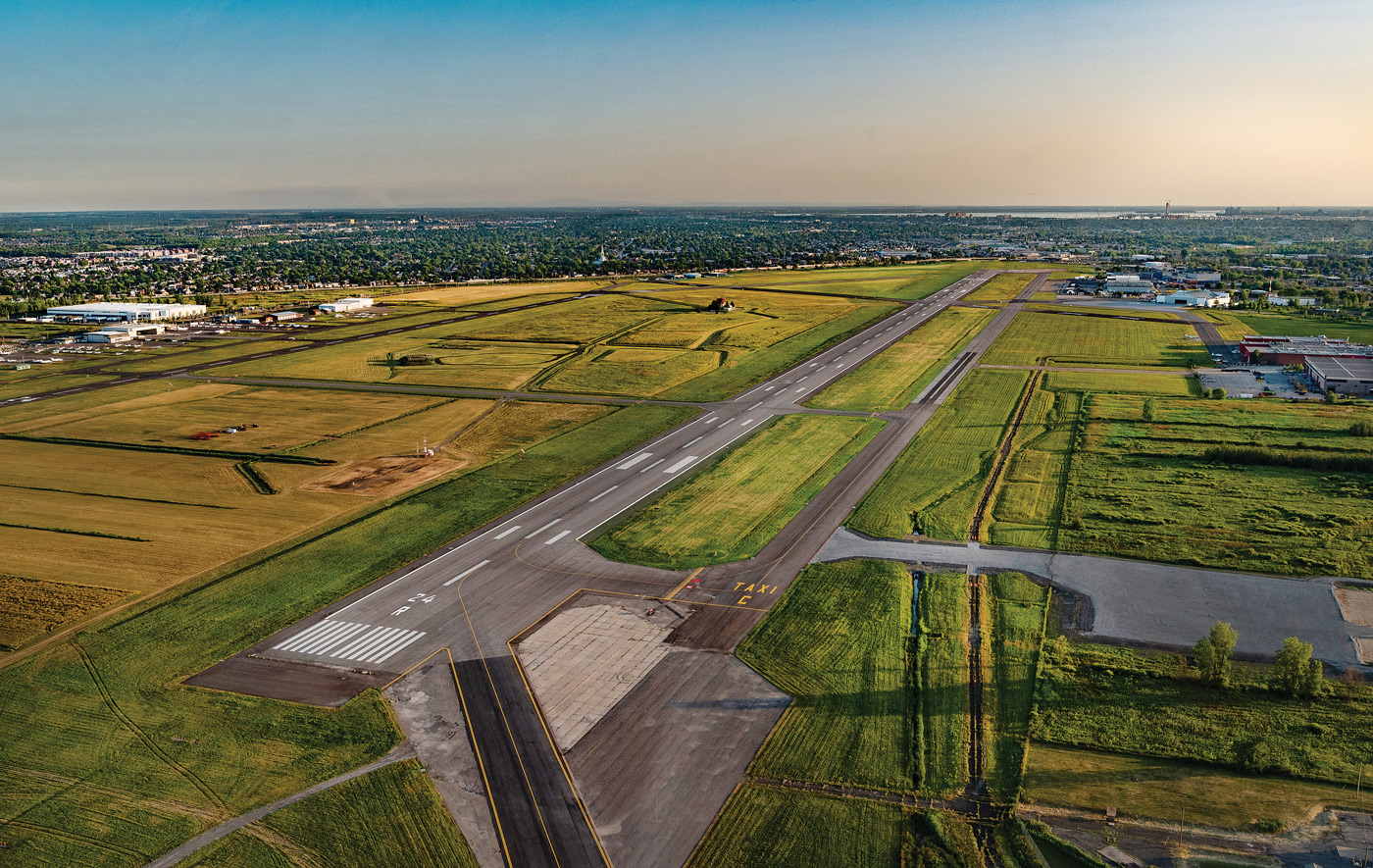Estimated reading time 4 minutes, 42 seconds.
In late August, a Boeing 737-200 airliner from Chrono Aviation, painted in the Quebec-based charter carrier’s matte-black livery, landed on the newly-resurfaced main runway at Montreal Saint-Hubert Longueuil Airport (CYHU).
It was a major milestone for Chrono, which planned to base the newly-acquired airliner at CYHU and offer charters for cargo and up to 120 passengers in the fall of 2018.
But the bigger story was the runway itself, which for the first time could accommodate larger aircraft like the 737 and the Airbus A319, A320, A321 and A220 family.

It was a key step in a plan to transform CYHU from a general aviation airport with a large contingent of flight schools to a regional hub and a secondary option for passengers flying out of Montreal-Pierre Elliot Trudeau International Airport.
“We’re actually closer to downtown Montreal than Trudeau is,” said Jane Foyle, general manager of Développement de l’aéroport Saint-Hubert de Longueuil (DASH-L), the not-for-profit corporation that operates CYHU.
“We’re not looking in any way to compete with Trudeau, because that wouldn’t make sense. We consider ourselves being able to offer a complementary service for Quebecers and Canadians.”
It’s a lofty goal, and CYHU must clear several hurdles before the dream becomes reality.
As it stands, the airport has no passenger terminal building, no Canadian Air Transport Security Authority screening services, and only has Canadian Border Services Agency services for 15 people.
Still, as passenger traffic increases and ultra-low-cost carriers (ULCCs) take off, CYHU has the potential to grow dramatically in a span of a few years.
“As we develop the airport, I think St. Hubert will be the place that ULCCs will turn to,” said Foyle.
“Trudeau is a different element–a big, international airport. And we’re so strategically located on the south shore, as well as 15 to 20 minutes from downtown Montreal.”
CYHU is one of Canada’s key aviation educational centres, with four flight schools: Air Richelieu, Cargair Inc., CPAQ-Aero and École nationale d’aérotechnique (ENA).
“We’re a very good contributor to the development of the aeronautical industry,” said Foyle, who joined CYHU in the spring of 2018.
“We see ourselves as–I don’t like to use the term hub in this case, but a centre for the development of the aviation industry in Canada and abroad.”
ENA is part of Quebec’s CEGEP system and has the capacity to train 1,200 student technicians each year, said Foyle. The airport also has three fixed-base operators (FBOs) selling fuel: Pascan Aviation, Avjet Aviation and AvFuel H-18.
Two additional FBOs are also in the works: Lux FBO, a division of Chrono Aviation, and Aeroparc H-19.
Pascan offers regular flights out of CYHU to various parts of Quebec, and Regional Sky is planning to offer an air taxi service five days per week to Providence, R.I., starting next spring.
CYHU also offers chartered flights from Chrono Aviation, Max Aviation, Aeroclub de Montreal and Univair, an Air Richelieu subsidiary.
Aero Teknic, a diversified maintenance shop and avionics dealer, is also based at CYHU, along with Handfield Aviation, a business and private aircraft maintenance company.
Other tenants include Aeromedic, the only privately-owned air medical provider in Quebec, and 438 Tactical Helicopter Squadron of the Royal Canadian Air Force.

CYHU is said to be the first civil airport built in Canada, tracing its history back to 1928. It became a base for the first air travel route between Canada and the United States, according to airport documents.
During the Second World War, the airport served as an Air Force training base, under the administration of Canada’s Department of National Defence (DND). It was transferred to Transport Canada in 1968 and then again in 2004 to DASH-L.
DASH-L is now trying to push the airport into an exciting new phase of growth.
CYHU saw 144,235 aircraft movements in 2017, an increase of 49 per cent from the year before. As of late October, DASH-L was projecting additional growth of five to 10 per cent in 2018.
The airport aims to have a new terminal in place by 2020-21 and is determined to provide a good financial offering so airlines will locate there. If all goes according to plan, CYHU will become a regional hub in less than a decade.
It might also keep travellers from the Montreal region from crossing the border and then flying further south.
“I would like them to be able to come back to Canada and to Quebec, particularly,” said Foyle.
In the past CYHU has been overlooked by large commercial carriers, but that may soon change. A steady buzz is building about that new runway and the potential it holds.
“We think that if the service was there, the population would certainly want to fly out of our airport,” said Foyle.
“So that’s where we are, and that’s where we want to go.”


What new runway? It is the same old runway that has been used for years by many airlines and the military. P&W used to operate their B720 engine test aircraft here, the Canadian military used to fly the North Star and the Boeing 707 from this runway. I worked for a charter company that flew the Montreal Canadians hockey team in and out of here on a B727.
As for terminals – the military had a terminal here for their service flights and back in the 1930s, the original Air Canada, TCA operated here.
There is lots of history at this airport. It even had a tower for tethering airships. Unfortunately due to noise complaints it will probably be stifled in any of its attempts to resurrect itself.
The current airport capacity and air traffic is already unlivable for most citizen on the south shore of Montreal. There is no curfew and many citizen can no longer sleep at night. There are no flight rules for recreative aircraft; the traffic is unacceptable. They circulate non stop just above residential areas, schools, parks, etc. Many accidents have already occurred.
The current air traffic, with no schedule, puts high pressure on house price on the south shore. The noise pollution and security puts high pressure on living quality. All complaints are denied and more so, no public consultation permitted.
The sound of planes is just like being in trudeau dorval area it’s sooooo disturbing
There is no continuity of air travel and you lose so much sleep as they buzz over head